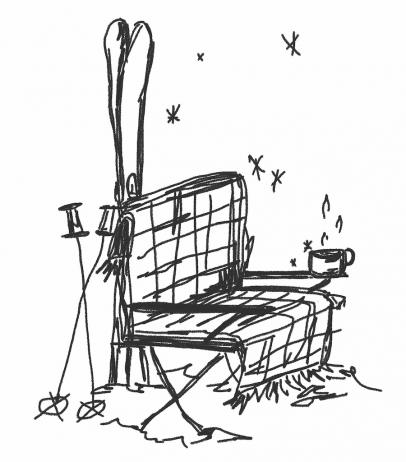Forever Après
For my birthday early last March, my husband bought me a nice bottle of Veuve Clicquot rosé. He knew I would like the champagne because it was pink and bubbly, but also because the bottle came with (no joke) its own jacket—a sleek, fitted pink case with a gold zipper and handsome leather handle to insulate the bottle and keep it cold, though that was not an issue when we drank it outside during an Aspen winter.
We cracked the bottle open in the parking lot at the base of the mountain and poured the champagne into plastic cups to share with our friends during what had become a weekly ritual: enjoying our own version of après-ski during that long COVID-influenced winter. Instead of packing into crowded bars, or herding our ruddy-cheeked, wild-haired children into base-area restaurants for overpriced hot chocolate they’d quickly lose interest in while we rushed to finish a pitcher of beer before the tired kids started having meltdowns, we would gather outdoors.
Every weekend, we’d meet up with other families after our ski day at an outer lot that’s popular among locals for its proximity to the lift and remoteness from bustling, touristy base areas. We would take up residence in the far corner of the lot, where several Sprinter vans were strategically parked to share common space, with the sliding doors facing each other for easy access to refrigerators and stovetops. Over the course of the winter season, our parking lot après setups became more elaborate, comprised of more and more of our best car-camping gear: an outdoor rug, a few collapsible tables adorned with red-and-white-checkered tablecloth, Yeti coolers, insulated Thermoses and can koozies, plastic plates and flatware, kerosene firepits, gas grills, and an assortment of slouchy camping chairs for lounging, often with down blankets draped across our laps to ward off the late-afternoon cold.
As our setup got more elaborate, so did our food. What started as a few beers cracked open from coolers that took up permanent residence in our vehicles became beautiful serving platters of charcuterie and cheeses; triangular bars of Toblerone, broken into pieces; hummus and crackers with an assortment of olives; and once, a fresh batch of chili served straight out of the hot pot with homemade cornbread muffins, sour cream, and shredded cheese. We ate it out of coffee mugs, still steaming hot. For the kids, I’d make real hot chocolate from full-fat milk and bars of Ghirardelli I’d melted over a double boiler the night before, piled high with mini-marshmallows straight out of the bag.
It’s true that sitting outside in the cold—trying to figure out how to drink cocktails with your mittens still on, or how to score the best spot for the most sun before it dropped below the ridge—was a necessity born out of COVID-19, when whatever pleasure could be gained from gathering inside had been desecrated by the inherent risk. But in many ways, spending time together outside was so much better. The kids could play, often sledding or building jumps so epic they had to put their skis back on. The adults could spend quality time together without worrying about who would pay the bill or how much it would cost or whether the last parking shuttle had already left. We could also eat—our fingers cold, cheeks flushed, and legs tired from a day on the slopes—satisfying our hunger but also feeding our souls.
Ali Margo is a freelance writer who lives in Basalt with her family and two pugs. She is thrilled to return to restaurants but her favorite meal is always at her home, surrounded by friends and family.





